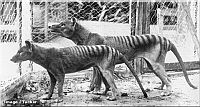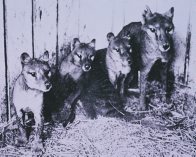The Thylacene Legacy
Monday, March 22nd, 2010 Possibly the last Tasmanian Tigers [Thylacinus cynocephalus]
in Hobart Zoo 1928.
http://www.naturalworlds.org/thylacine
Possibly the last Tasmanian Tigers [Thylacinus cynocephalus]
in Hobart Zoo 1928.
http://www.naturalworlds.org/thylacine
.
Any species (carnivorous or herbivorous) that was perceived as an obstruction to man’s so called “progress” was killed through either direct assault by shooting, trapping and laying poisoned baits, or by simply obliterating its habitat.
The thylacine is a classic victim of greed, false notions, irrational opposition toward native wildlife and apathetic attitudes. Thousands of these magnificent animals were killed by Tasmania’s farming community in a misguided attempt to protect alien livestock such as sheep that didn’t belong on the island in the first place.
When compared to other factors, it is unlikely that many domestic animals were actually taken by thylacines. For example, historical records show that the majority of sheep losses were in reality attributable to thieves and predation by feral domestic dogs. Indeed, loss of stock due to thylacines was probably never substantial enough to be economically significant.
In the case of Tasmania, it was unfortunately the thylacine which became the settlers’ target of blame for agricultural troubles. As has so often been the case, a wild, misunderstood species was accused of “getting in the way of development”.
Presented on the Natural Worlds website “is a gallery of twelve historical photographs which date from the late 18th to early 19th centuries. They are a poignant visual record of one of man’s most hurtful actions toward his marsupial cousins. The scenes depicted in this gallery are highly unpleasant, but they should not be forgotten.
 Adult Thylacine with young
© Australian Museum
http://australianmuseum.net.au/image/Adult-Thylacine-with-young/
Adult Thylacine with young
© Australian Museum
http://australianmuseum.net.au/image/Adult-Thylacine-with-young/
.
The persecution of the Thylacine is not just a terrible blight on Australian history, but indeed, that of the world at large. Like all species, this animal is a part of the natural heritage of the planet as a whole – the product of millions of years of evolution. Places which still retain populations of other endangered species would be well advised not to let a similar tragedy befall them.” [Source: C. Campbell’s Natural Worlds 2006, www.naturalworlds.org/thylacine]
.
.
‘Kumanjayi Tiger’
.
Aboriginal Australians hold a cultural taboo against seeing images of the deceased.
Central Australian Aboriginal peoples have traditionally used the term “Kumanjayi” to precede the name of a deceased person.
Did Australian Aboriginal peoples ever force the extinction of a species? Probably not. So the British word ‘extinction’ may probably not have an equivalent term amongst the Australian Aboriginal languages making up over 400 distinct nations that existed across Australia before the 1788 Australian Invasion.
Colonial Australians, dominated by the British, have forced the extinction of many species endemic to Australia, notably and distressingly, the Tasmanian Tiger. Cameron Campbell on his website www.naturalworlds.org provides a rare collection of historical images of the now extinct Tasmanian Tiger. This extinction is one of the most avoidable in history and so or the more tragic and condemning of colonial Australia’s culture. Campbell’s images and old videos convey a magnificently healthy top order predator fine-tuned through eons of Darwinian evolution to survive and thrive in Tasmania’s harsh wild country.
But colonist culture of the time treated the tiger misguidedly like vermin and so in primitive eyes despised it, hunted it, skinned it and ultimately exterminated it from the planet.
Australia is a unique and special island-continent and out of respect for our country, we should start respecting its natural values and embrace its traditional cultures. All of Australia’s natural fauna and flora are endemic: that is, they exist nowhere else on the planet. So how can we as supreme custodians chose to neglect, exploit and destroy this privileged closenessto such uniqueness?
With our knowledge of the existence values and of the human threats to native species, we must stop in our tracks to save the remaining species and their habitat before they are gone.
This website respects the prominence of local Aboriginal rites and advocates a name change of the Tasmanian Tiger to ‘Kumanjayi Tiger’. Should we be able to see images of it without feeling a strong sense of cultural taboo by actively persecuted to extinction? The tiger lives on now only in myth as Australia’s own proud, vibrant, healthy and uniquely Australian top order species.
If any man admires his dog, this was a magnificently wild native dog like no other.
That we killed it to extinction is an abomination.
.
© The Habitat Advocate Public Domain









